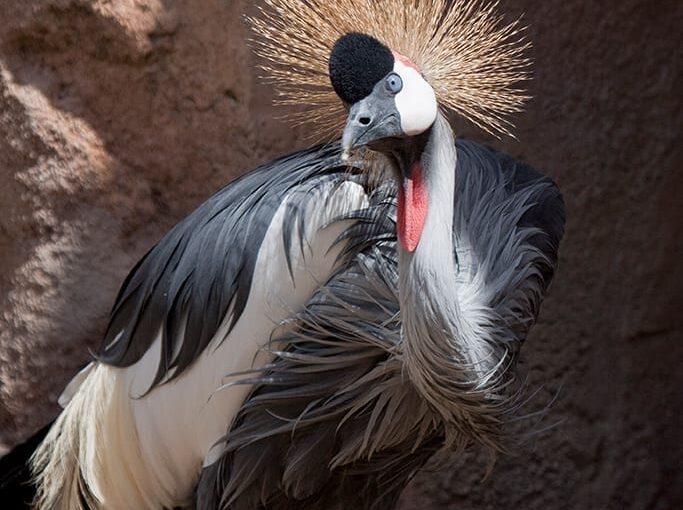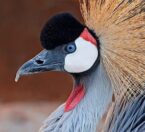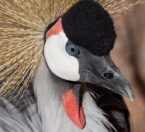All cranes participate in spectacular dance routines involving head-bobbing, wing-fluttering, leaps and deep bows, running with wings flapping and even short, low flights. These elaborate dances serve as courtship rituals to attract mates. For young birds, dancing helps develop physical and social skills, but spontaneous dancing can occur anytime during the year. In a flock of cranes, if one bird starts dancing soon all the others join in. In many cultures, including Native Americans, Australian aboriginal peoples, African tribes and the Ainu of Japan, humans mimic crane dances.
Classification
| CLASS: | Aves |
| ORDER: | Griformes |
| FAMILY: | Gruidae |
| GENUS: | Balearica |
| SPECIES: | Regulorum |
Habitat & Range
This species of bird prefers wetlands with nearby grasslands and cultivated land near rivers and lakes.
East Africa from northern Uganda and Kenya south to Zimbabwe, Botswana and Namibia.
Location


Adaptations
- Stamp Your Feet
- Crowned cranes stomp their feet as they walk across grasslands. This flushes out insects and other potential prey that the cranes quickly catch and eat. Cranes are also often seen moving among herds of large mammals to feed on the insects frightened by herd movement.
- Crane Chorus
- Living in large flocks, cranes have developed several methods of communication. All cranes are noted for their loud calls that can be heard over three miles (five km) away. Crane chicks start learning the meaning of various calls soon after they hatch. The unique “unison call” of a mated pair of crowned cranes announces their presence in occupied territory and warns other birds away. This call is a duet that begins when the male emits a series of long, low calls. The female answers with several short, high-pitched calls. Other nearby crane pairs return the calls to establish their territory resulting in a chorus of crane calls echoing across the area. Other forms of crane communication include body postures and displays that can signal aggression, threats or submission toward other birds.
- Dance, Dance, Dance
- All cranes participate in spectacular dance routines involving head-bobbing, wing-fluttering, leaps and deep bows, running with wings flapping and even short, low flights. These elaborate dances serve as courtship rituals to attract mates. For young birds, dancing helps develop physical and social skills, but spontaneous dancing can occur anytime during the year. In a flock of cranes, if one bird starts dancing soon all the others join in. In many cultures, including Native Americans, Australian aboriginal peoples, African tribes and the Ainu of Japan, humans mimic crane dances.
Physical Description
- Crowned cranes stand 44-48 inches (112-122 cm) tall; males are slightly taller on average.
- They weigh six to eight pounds (3-4 kg).
- They have a wingspan of six and a half feet (2 m).
- They have slate grey feathers on their body. Wings are white with black and chestnut coloring.
- These birds are named for the distinctive, bristle-like, golden feathers on top of their black head.
- They have a bright red patch above white cheeks and a red neck wattle.
- Their long legs and beak are black.
Diet
What Does It Eat?
In the wild:
Seeds, plants, grain, insects, worms, frogs, lizards, small fish and eggs. They forage on agricultural land.
At the zoo:
Nutritional crane pellets and assorted greens.
What Eats It?
African predators including hyenas, lions, leopards and cheetahs.

Social Organization
Crowned cranes are social and gregarious birds living in flocks of up to 200 birds during most of the year. During breeding season, mated pairs establish and defend a nesting territory using their loud calls to warn other birds away.
Life Cycle
Like other cranes, East African crowned cranes are monogamous and pair for life. During breeding season, both males and females participate in graceful and elaborate mating dances. Once paired, mated couples build a large circular nest, made of grasses and vegetation, in a secluded area of marshy ground. The female lays up to four bluish-white eggs, and both parents incubate the eggs; females incubate at night and males during the day. The eggs hatch after 28-31 days. Crane chicks are well developed when they hatch and within a few hours can follow the parent birds around learning how to forage for food. The chicks develop flight feathers at two to four months but after fledging stay with their parents for eight to ten months, until the next breeding season. After leaving their parents, young birds gather with other juveniles and move to new foraging and roosting sites. By 18 months the young have developed adult plumage and begin practicing threat displays and mating dances. East African crowned cranes are fully mature by two to three years of age; these birds can live 20-40 years.years in captivity.













